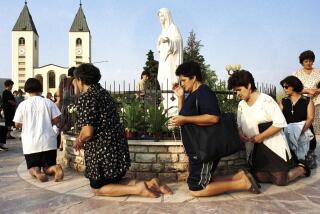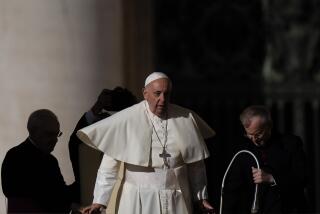Vatican issues new guidelines on sexual abuse cases
Reporting from Rome and London — The Vatican issued new in-house rules Thursday that it said would make punishing sexually abusive priests easier but critics declared the effort short on real change.
Under the revised regulations, the Holy See can fast-track the defrocking of a cleric guilty of child molestation. The rules extend the statute of limitations within church law in such cases and define sexual abuse of the mentally disabled and possession of child pornography as canonical crimes for which a priest can be stripped of his clerical status.
But in many ways, the revisions — contained in the first major document issued by the Vatican since a sexual abuse scandal erupted this year in Europe — merely make official what is already working procedure within the church. They also do not explicitly require that sexual misconduct be reported to police or that bishops who hush up such crimes be disciplined, as critics have demanded.
“Tweaking existing church policies won’t have real impact on bishops’ behavior and won’t make the changes that kids need to be safe,” said David Clohessy, director of the Survivors Network of those Abused by Priests.
And controversially, the new document classifies the attempted ordination of a woman as a canonical crime equal in gravity to molesting minors and heresy. That has outraged advocates of greater rights for women within the Roman Catholic Church, many of them in the United States.
Msgr. Charles Scicluna, the Vatican’s internal prosecutor, defended the revised rules as an important step because they codify the Vatican’s policy on dealing with sex offenders, leaving no room for doubt on the penalties that can be imposed. Many elements of the policy have already become common practice but did not, until Thursday, have the force of canonical, or church, law behind them.
“That is a step forward, because the norm of law is binding and is certain,” Scicluna told reporters.
Victims of child molestation can now bring a case against their abusers up to 20 years after their 18th birthday, double the previous statute of limitations. Church officials can extend the time further if circumstances warrant, a practice that has also become routine.
But the new rules are silent on whether such crimes must be reported to civil authorities. Scicluna said that such a provision lay outside of the scope of the document issued Thursday, which deals only with internal procedures.
A separate set of guidelines — albeit not binding — released in April said that sexual molestation cases should be turned over to police.
“If civil law requires you report, you must obey civil law,” Scicluna said, adding that “it’s not for canonical legislation to get itself involved with civil law.”
Critics say the Vatican has long been deliberately nebulous on whether allegations of clerical sex abuse should be dealt with purely internally or also in the civil sphere.
They say that both as pontiff and when he was the cardinal in charge of the Congregation for the Doctrine of the Faith, the office that deals with sexual impropriety, Pope Benedict XVI has allowed secrecy to reign, fostering a culture where preventing scandal and preserving the church’s reputation is more important than redress and justice for victims.
“I found puzzling and dismaying the fact that there is no obligation to report [sexual abuses] to civil tribunals” in the revised regulations, said Marco Politi, a respected Vatican-watcher.
He called it a “step backwards” for a pope who recently declared that “repentance is not enough — there must also be justice.”
The new document deals with both sacramental and moral crimes. Under the first category is the attempt to ordain a woman, which can result in defrocking for the priest who tries to do so, the same potential punishment for a child molester.
Scicluna said that publishing the two canonical crimes in the one document was not intended to imply that they were the same qualitatively. Both are considered “grave” but in different ways.
He noted that other sacramental crimes, such as apostasy and heresy, were also included in the document.
Special correspondent De Cristofaro reported from Rome and Times staff writer Chu from London.
More to Read
Sign up for Essential California
The most important California stories and recommendations in your inbox every morning.
You may occasionally receive promotional content from the Los Angeles Times.











